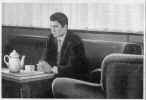|
MONDAY, JANUARY 15, 2001
this
& that
|
|
|
 You
are what you eat. The
Rainbow Warrior has discovered America’s
supermarkets. At the ripe old age of 25, Greenpeace
has launched a new fleet to sail the tempestuous
seas of genetically engineered foodstuffs.
Continuing its tradition of flamboyant activism, the
environmental organization dispatched FrankenTony, a
“genetically mutated version of Kellogg’s Tony
the Tiger,” to the cerealmaker’s corporate
headquarters in Battle Creek, Michigan to deliver a
wheelbarrow load of StarLink corn, along with 20,000
protesting petitions. It also set up the True
Food Network to provide information about
companies that have been naughty (Wonder bread,
Beech Nut baby food, Hi-C juices) and nice (Alvarado
Street bread, Gerber’s baby food, Odwalla juices).
There’s fun for the whole family, including online
postcards, silly screen savers, and stickers to
download. You
are what you eat. The
Rainbow Warrior has discovered America’s
supermarkets. At the ripe old age of 25, Greenpeace
has launched a new fleet to sail the tempestuous
seas of genetically engineered foodstuffs.
Continuing its tradition of flamboyant activism, the
environmental organization dispatched FrankenTony, a
“genetically mutated version of Kellogg’s Tony
the Tiger,” to the cerealmaker’s corporate
headquarters in Battle Creek, Michigan to deliver a
wheelbarrow load of StarLink corn, along with 20,000
protesting petitions. It also set up the True
Food Network to provide information about
companies that have been naughty (Wonder bread,
Beech Nut baby food, Hi-C juices) and nice (Alvarado
Street bread, Gerber’s baby food, Odwalla juices).
There’s fun for the whole family, including online
postcards, silly screen savers, and stickers to
download.
You are what you breathe. For several years
the EPA has argued that teeny tiny particles in the
air — measuring, say, less that 1/5 the diameter
of a strand of hair — do a whole lotta damage.
Turns out that fine particulate pollution, to use
the scientists’ term, is everywhere, comes from
nearly everything, including exhaust pipes, tires,
electric plants, and fireplaces. The more there is
of it, the more likely people are going to suffer.
Thousands died of exposure to a dirty London fog in
1952. In other parts of the world, hundreds of
thousands suffer yearly from bronchitis or acute
asthma.
In 1997, when the EPA decided to institute new
stringent standards for ozone and particulate
matter, industries fought back, filing lawsuits and
questioning the agency’s science. In 1999 the
District of Columbia Court of Appeals blocked the
new regulations; this year the case goes before the
Supreme Court. Now the cavalry has arrived just in
the nick of time, in the form of a new study out of
the Johns Hopkins School of Public Health. The Environmental
News Network reported on January 10 that
“as levels of particulates less than 2.5
micrograms increased in the air, so did the death
toll.” As simple as that. Or maybe not. An
editorial published on December 14 in the New
England Journal of Medicine , which carried the
original Hopkins study, notes that “a reduction in
24-hour exposures to levels consistently below the
current range would be prohibitively costly, if not
impossible, in the foreseeable future.” The only
course, the journal says, is “an aggressive
research program” leading to “more focused
regulatory strategies that will simultaneously
protect the public health and the nation’s
prosperity.” No one is breathing easy yet.
Where did the year go? Victor Miller tells us
what it was like in his part of the city, in a
commentary entitled Dotterdämmerung in the January
New Mission News. It’s a rip-roaring article.
Miller sets the scene: “The year began miserably.
House-hungry stock-option wolf packs circled the ‘hood,
pouncing on the most vulnerable members — seniors,
single moms, and semi-documented families —
forcing them out of their homes by hook (‘This is
perfectly legal’) or by crook (‘Don’t make me
call Immigration / get the cops / put you on the
tenant blacklist’). In the early months of 2000,
the predators of the new (but narrow) prosperity
barreled along, transforming the Mission’s
multicultural richness into a monoculture of the
rich.” May you live in interesting times.

The Monarch, old and new. Once-and-current Examiner
editor Dave Burgin, during his early 1970s sojourn
as sports editor of Hearst’s Ex, was known to be
inordinately fond of revealing the contents of his
office desk drawer. In it were piled
never-to-be-used gift certificates from the
management of local professional sports teams.
Burgin’s refusal to compromise his independence
and the way his staff went about its reportage, was
a principled and precedent-setting approach to
sports coverage which he also utilized on sports
pages he headed in two other cities. He insisted,
for instance, that none of his writers ever travel
on a team plane unless the newspaper, and not the
team, footed the bill. Upshot: Displayed prominently
on the first page of Tuesday’s Ex Files section of
the Examiner, was an announcement about the showing
of Oakland painter Mark Stock’s work at a Market
Street gallery, with a reproduction of one of his
canvases and a 135-word biographical description.
The concluding sentence adds that the gallery will
also be celebrating the recent publication of a book
of Stock’s paintings by Metropolitan Books/Woodford
Press. Absent from the text was any mention of Dave
Burgin, a founder and owner of Woodford Press. (Photo:
San Francisco Examiner)
B.C.
|
|
|
|
|
|
|